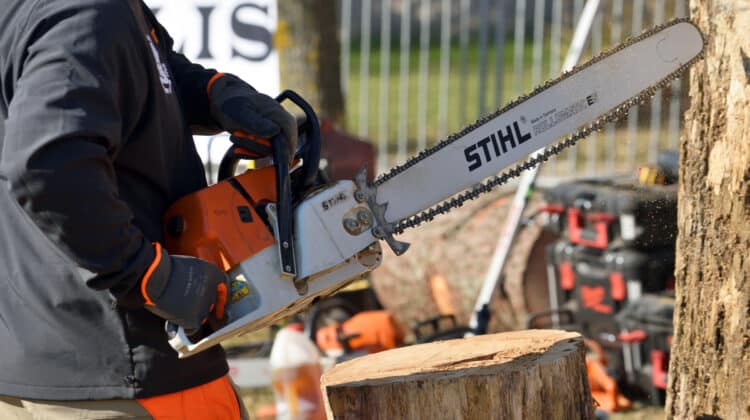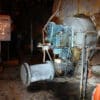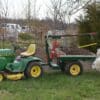
Generally speaking, an air filter should be thoroughly cleaned after each usage daily. When operating in severe conditions, the air filter is recommended to be examined and cleaned every time you refuel. If a cut or hole develops in the filter, it should be changed as soon as possible. The good news? Figuring out how to clean chainsaw air filter assemblies isn’t very hard.
Let’s get to know first what tools you need to know for cleaning air filters on a chainsaw!
Table of Contents
What Is A Chainsaw?
A chainsaw is a large, heavy-duty piece of technology that is effective and dangerous in its operation. The chainsaw is hugely adaptable and is built to withstand the most difficult situations while still performing at optimum levels for long periods. It is also quite durable.
Many chainsaws need you to replace the air filter once a year. However, according to manufacturer recommendations, it’s a good idea to clean it after roughly five hours of mixed-use.
A clogged air filter might cause the chainsaw to lose power and, in some cases, quit altogether. Here’s how to properly clean your air filter, as explained in this article.
Air Filter
An engine’s air filter is a part that is installed in the machine. In the process of filtering the air as soon as it reaches the motor, it eliminates contaminants. It stops them from going into the fuel system and engines.
The air filter guarantees that the carburetor operates at peak performance keeps the engine protected from wear and strain and helps the engine to last for an extended period.
Reasons For Cleaning The Chainsaw Air Filter
If an engine is currently operating, it is constantly sucking in the fresh air. Before reaching the engine, this air is going inside with into a filter to ensure that the process of combustion goes as well as possible. Wear and strain on the machine are kept to a bare minimum, as described above.
This is done to filter the undesired things such as wood splinters, concrete dust, and other delicate material from the air and prevent them from going into the engine. They can do significant damage if they join.
To do this, several STIHL chainsaws and cut-off engines are equipped with an advanced long-lasting air filtration system.
For Chainsaws:
Several chainsaws from STIHL are equipped with a unique long-lasting air filter system that includes channeling to alleviate pressure on the filter components. It operates in the following way:
To flush out bigger and heavier dust roaming around the air, the intake air must first be turned on and allowed to circulate. This firstly filtered air is carried down the routing track to the STIHL power tool air filter engine.
The intake air is subsequently passed through a high-performing air filter, which ensures that the air provided to the machine using the carburetor or injection system from STIHL is free of contaminants.
Since this air filter is replaceable in several of the power tools, the filtering material may be customized to meet users’ needs. Examples are polyamide filtering for cold temperature, or the quality-performance, unique HD2 air filter which is made of the polyethylene filter medium.
Since the HD2 air filter holes are smaller than those found in polyamide filters and fleece by 70%, they can successfully filter even the tiniest dust particles.
It also has both water and oil resistance and a very effective covering that stops unfiltered air. This is to prevent it from entering the engine, extending the engine’s service life.
Furthermore, HD2 air purifiers are simple to clean and can be used numerous times again.
For Cut-off Tools:
Cutting machines from STIHL are equipped with a long-lasting air filtration system that comprises a paper filter, cyclone routing, and a fine dust filter, among other features. Because of the revolutionary cyclone routing technology, there is no need to filter it daily. Also cleaning and the filter service life is significantly increased.
The routing from cycling removes the dust particles by almost 80% present in the input air stream during the first phase. This is in contrast to typical systems, in which particles are collected in the filter and then sent back into the surrounding environment along with the cooled air.
Following that, the paper filter eliminates any remaining particles from the air after passing through the routing system. Doing this intelligent routing contributes to the extension of the service life. The dust filter captures practically all of the smallest dust particles following the paper filter, even those with the most minor diameters.
Advantages Of Using The STIHL Air Filtering Tool
- Routing lowers the amount of excessive usage on filters downstream due to methodical cleaning.
- Load is transferred away from the high-performing air filter, which results in improved filtration.
- Cleaning and replacement intervals for the filter significantly increase, resulting in a much longer filter service life. According to the use and its material, these intervals might vary.
- Air filters with long service life and ease of use are available from STIHL and do not need extra maintenance.
- Maintenance is simple: cleaning the air filter on a chainsaw is an easy process. Instructions on how to complete the procedure are included in the guiding manual.
Other Tips In Cleaning The Air Filter:
- Every chainsaw is unique. It’s usually behind the engine, at the top. Look for a raised circular region on the chainsaw’s body. This portion will also feature slits to allow for optimum air circulation. Remove the cover screws with the screwdriver and set them aside. Remove the chainsaw’s cover and set it aside.
- A second cover towards the engine’s back is likely under this one. Remove additional screws. Remove the air filter cover and leave it aside. The air filter should be easily removed.
- One of the buckets should be filled with soap and hot water. Check to see if the water is sudsy. Take the air filter and carefully tap it on a hard surface to remove any excess moisture.
- Instead of tapping the filter itself, tap the rough plastic edge. Dust will be loosened, and particles will fall off the filter as a result of this. When you’re ready, you may submerge the filter in a pail of hot water and soap for a few minutes.
- Gently scrape the filter with a toothbrush after it has been swishing in the water for a few seconds. Allow the filter to sink to the bottom of the bucket and rest for a few minutes before swishing it around the water to clean it out.
- Using cold water, fill the second bucket halfway. As soon as you have completed cleaning the filter in the bucket of hot water, transfer it to this bucket. Move the filter around the cold water to remove the soap and soap residue from the water. You may take the filter out of the machine and lay it aside to dry when you’re finished.
- Make a second bucket of iced water. After washing the filter in hot water, place it in this container. Move the filters around in the chilly water to eliminate the soap. After that, replace the filter and let it dry naturally.
- Wipe the filter and chainsaw coverings to prevent dirt from getting into the clean air filter. Scrub the blankets with hot water. After cleaning the insides, wash them with cold water. Change the air filter when the filter and covers are dry. Replace the filter cover and chainsaw body.
- Tighten the screws gently.
Long-Lasting Air-Filtering Tool
Routing and an HD2 air filter are included in purchasing a STIHL chainsaw with a long-life air filter system. Compared to standard filter systems, this configuration provides a much longer filter service life.
When using a long-life air filter system, you can expect the motor to last for a long time. This will prevent early wear on the pistons and cylinder and protect against contamination of the mixture. When you detect a decrease in power, STIHL advises cleaning your air filter.





